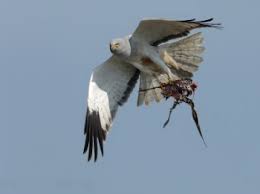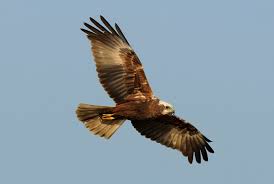Northern- (Northern Netherlands, Wadden), marsh- (largest) and Montagu's (smallest) harriers are seen here.
They fly low over the ground with a lot of spin, swing and briefly hovering. They nest on the ground.
T he marsh harrier (Circus aeruginosus) is 42-55 cm, wingspan 115-140 cm, and has black feathers. The male is 540 grams, the female 740 grams. The legs are yellow and the nails black.
he marsh harrier (Circus aeruginosus) is 42-55 cm, wingspan 115-140 cm, and has black feathers. The male is 540 grams, the female 740 grams. The legs are yellow and the nails black.
The marsh harrier is larger than the buzzard and has long slender wings and a long tail. Typically, they hold their wings in the gliding flight up in a 'V'.
They have no specific drawings, are sometimes reddish mottled.
They nest in old, tall reeds and overwinter in Africa. The eggs are bluish white / greenish white, the scale is not shiny.
The marsh harrier hunts small mammals, birds and amphibians (and insects), which the bird plunges from a diving punch on top of the prey.
Attack on chickens is unknown.
 The Northern harrier also is wintering in Africa.
The Northern harrier also is wintering in Africa.
The Northern harrier (Circus cyanus) is measuring 45-55 cm, wingspan is 97-118 cm. The male weighs 350 grams, the female 510 grams. They have a white rump.
She breeds in moist places in open taiga, swamps, shallow lakes and bogs. His ground nest contains 4-6 dof white eggs. Males can have more than one wife.
Here too are small mammals and poultry on the menu.
Prey remains are sometimes recognizable to longitudinally open extracted abdominal skin from which intestines are eaten.
It is quite rare, sometimes seen in the Wadden Islands.
Montagu's harrier (Circus pygargus ) is also rare, sometimes seen in North Groningen.
